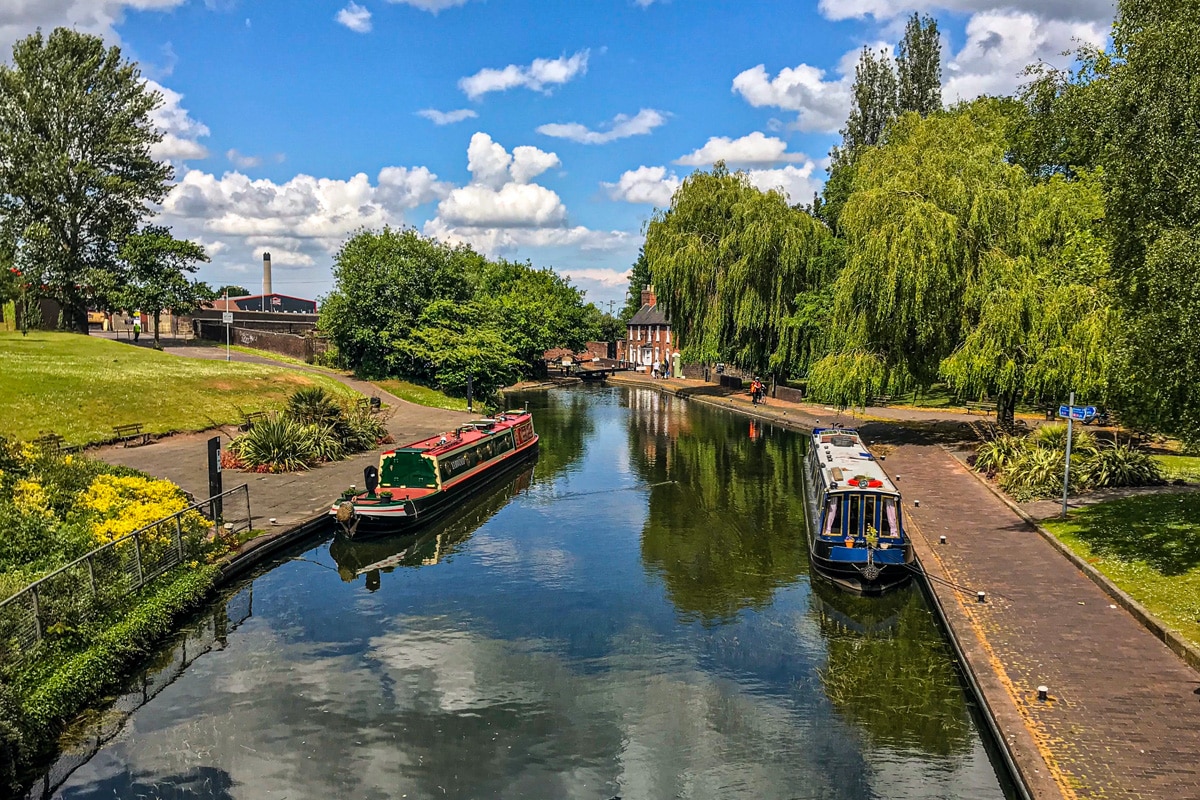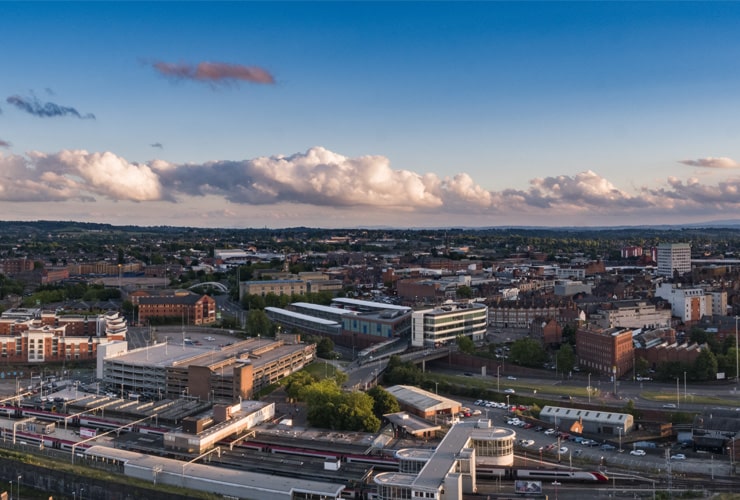Areas of Wolverhampton: Buy-to-Let Property Investment Hotspots
Wolverhampton isn’t a place that often comes to mind when you think of the UK’s biggest cities. But Wolverhampton IS one of the UK’s biggest cities. And that means it’s one of the UK’s biggest property markets too. That Wolverhampton also has some of the cheapest investment property in the country only adds to its attraction for property investors.
Why Invest in Wolverhampton?
Wolverhampton has a population of around 256,000, which is expected to grow to 288,000 over the next few years. As a city, compared to the nearby Birmingham population of 1.14 million, Wolverhampton offers a smaller but significant investment market within the West Midlands conurbation.
Yet its size makes Wolverhampton the 10th biggest city in the UK, and with a wider area, with a population of 1.2 million, one of the largest urban areas in the country.
Wolverhampton became a city in 2001. Since then, its profile has been raised, attracting more investment and development. The city is historically part of Staffordshire, but local services are now provided by the City of Wolverhampton Council.
The city is a historic place. The original town was named after Wulfruna, an Anglo-Saxon noblewoman, and dates back to 985 AD.
Wolverhampton grew rapidly during the Industrial Revolution, becoming a centre for heavy industries such as foundries and metalworking. The area around the city is known as the Black Country due to its smoky, industrial past.
Today, Wolverhampton is still an industrial centre but with more modern industries such as manufacturing, technology, and engineering. It is considered the centre of the UK aerospace industry, with around 20% of the country's aerospace manufacturers located in the area.
Wolverhampton has excellent transport links, making it attractive to businesses. It is also a popular commuter location for those working in the West Midlands region. The city is close to the M5, M6, M6 Toll, and M42 motorways. There are direct rail services to Birmingham in just 17 minutes, as well as London, Manchester, and further afield. The city also benefits from a direct tram link to Birmingham city centre.
While Wolverhampton may not be known as one of the UK's major tourist destinations, it has all the amenities residents could need. The Mander Centre and the Wulfrun Shopping Centre are located in the city centre, with retail parks in the suburbs. Wolverhampton is also known for its Premier League football club, Wolverhampton Wanderers FC, and Wolverhampton Racecourse.
Wolverhampton has seen a decline in the later part of the 20th Century, due to the fall of traditional industries. However, there has been significant regeneration in the city, with more planned. The City of Wolverhampton Council has outlined ambitious growth plans, with around £4.4 billion expected to be invested in the city over the next few years.
Recent and upcoming projects include the £175 million Wolverhampton Interchange, providing seamless transfers between rail, bus, and metro, and the i9 and i10 grade A office developments. A £55 million regeneration project for the city centre, known as Westside, will bring a multi-screen cinema, family leisure attractions, and restaurants. Other projects include Brewers Yard, Canalside, Molineux Quarter, and the Commercial District, further supporting Wolverhampton's prospects for capital growth and increasing rental yields.
Wolverhampton has seen a lot of industrial regeneration, attracting new businesses and jobs. The i54 business park, home to Jaguar Land Rover's advanced engine manufacturing plant, has sustained nearly 3,000 jobs and is expanding with a western extension expected to generate 1,700 new jobs.
The University of Wolverhampton is also driving economic growth in the area, with a vision to generate £250 million in investment by 2020. The university has invested in new buildings and courses, attracting a significant number of new students.
Wolverhampton has a fast-growing economy, a growing population, and strong rental demand. It offers lower investment costs, excellent potential for capital growth, and high rental yields. With its ambitious plans for the future, Wolverhampton presents a great opportunity for savvy investors.

Transport Links
Wolverhampton has excellent transport links, making it easily accessible from various parts of the UK.
- By Road: Wolverhampton is close to the M5, M6, M6 Toll, and M42 motorways, providing easy access by road.
- By Rail: Wolverhampton railway station, located on the West Coast Main Line, offers direct rail services to Birmingham (in under 20 minutes), London, Manchester, Scotland, Wales, and various other destinations across the country. The station is served by London Midland, CrossCountry, Virgin Trains, and Arriva Trains Wales.
- By Air: The nearest airport is Birmingham Airport, which is easily accessible from Wolverhampton by coach or train.
- By Bus/Coach: Wolverhampton is well-served by public bus services, with connections to various towns and cities, including Birmingham, Bridgnorth, Telford, Shrewsbury, Manchester, Leeds, London, and many others.
- By Metro: The West Midlands Metro provides a light rail/tram service connecting Wolverhampton with the wider West Midlands area. The recent Wolverhampton City Centre Metro Extension has improved transport within the city, linking the bus and railway stations and creating a seamless multimodal transport network.
Property Values
The West Midlands region is known for its good-value property prices, and Wolverhampton is no exception, making it a good option for buy-to-let landlords looking to reduce property purchase costs.
The average house price in Wolverhampton is currently £235,000 as of March 2024, according to OnTheMarket, which represents a slight fall over the last 12 months. Other sources, such as GetAgent, put the average house price at £257,839, while Home.co.uk reports a higher average asking price of £273,892.
The price of property in Wolverhampton varies depending on the type of property and the area. The most affordable place in Wolverhampton is 'WV1 3', with an average price of £115,000, while the most expensive is 'WV5 7', with an average price of £734,000.
- The average price of an established property is £231,000, while a newly built property costs £273,000.
- Detached houses in Wolverhampton currently fetch an average of £451,429, while flats average £113,131.
- The cheapest property you can buy in Wolverhampton is around £60,000.
Average Asking Price by Postcode Area
Last updated: August 2024
Data from propertydata.co.uk
| Postcode District | Average Property Price |
|---|---|
| WV1 | £163,665 |
| WV2 | £202,970 |
| WV3 | £287,051 |
| WV4 | £282,630 |
| WV5 | £392,303 |
| WV6 | £319,502 |
| WV7 | £344,458 |
| WV8 | £375,367 |
| WV9 | £282,016 |
| WV10 | £238,386 |
| WV11 | £239,838 |
Rental Demand
Wolverhampton's landlords will find their buy-to-let properties are let mainly to residents, commuters, and students.
The average monthly rent in Wolverhampton is £693, according to a survey by HMRC's Valuation Office Agency. Rents in Wolverhampton are significantly lower than the English average of £994.
The average rent varies depending on the type of property. A single room can start from £342, while a four-bedroom house can go up to £1,090.
The most common type of rental property in Wolverhampton is a three-bedroom house, accounting for 36.2% of properties.
The Wolverhampton Market Rent Summary provides more detailed information on average rents for different property types:
- £728 PCM for a one-bedroom property
- £1,134 PCM for a two-bedroom property
- £1,240 PCM for a three-bedroom property
- £1,577 PCM for a four-bedroom property
- £2,174 PCM for a five-bedroom property
Rental demand in Wolverhampton is expected to remain solid, and it may even improve due to changing working patterns and an increasing population of renters.
The city's convenient transport links and proximity to major cities like Birmingham and Manchester also contribute to its appeal for renters.
Low property prices and strong rents mean that Wolverhampton landlords can achieve competitive rental yields. Research suggests yields can range from around 4% to 9.7% in the Wolverhampton WV postcode areas.
Average Rental Yield by Postcode Area
Rental yield is the rental return an investor can expect on their investment once costs have been taken into consideration.
Last updated: August 2024
Data from propertydata.co.uk
| Postcode District | Average Rental Yield |
|---|---|
| WV1 | 6.0% |
| WV2 | 5.5% |
| WV3 | 4.2% |
| WV4 | 4.6% |
| WV5 | - |
| WV6 | 4.1% |
| WV7 | - |
| WV8 | - |
| WV9 | - |
| WV10 | 5.9% |
| WV11 | 5.3% |
Landlord Licensing
The City of Wolverhampton Council has licensing in place for HMOs (the standard national license, handled by the city authority) as well as Article 4 directions.
The council has not created any Selective Licensing areas as of January 2024. However, it retains the right to introduce Selective Licensing in the future if certain conditions are met and anyone thinking of buying a rental property in Wolverhampton should keep an eye out for any announcements.
HMO Licensing
The Housing Act 2004 enforces a mandatory licensing scheme for certain Houses in Multiple Occupation (HMOs). In Wolverhampton, a licence is required for properties where:
- The property is occupied by five or more people, making up more than one household.
- Tenants live in the property as their main or only residence.
- There are shared facilities such as a kitchen, bathroom, or toilet.
The City of Wolverhampton Council provides an online platform to apply for an HMO licence.
Article 4 Directions
The City of Wolverhampton Council introduced an Article 4 Direction in 2017, for the whole city area, which requires planning permission to change the use of a house to a small HMO accommodating three to six people. This measure was implemented to control the proliferation of smaller properties being converted into HMOs and to maintain good living standards for tenants.
Rent with Confidence (RwC)
Wolverhampton offers landlord accreditation for private landlords and letting agents. The Rent with Confidence (RwC) scheme aims to improve the quality, standard of property conditions, and management of the private rented sector. Accredited landlords and agents undergo training and comply with a code of conduct, gaining recognition as reputable landlords.

The Best Places to Live in Wolverhampton
Wolverhampton has a variety of desirable neighbourhoods, each with its unique character and appeal. Here are some of the best places to live in Wolverhampton:
- Tettenhall: Located just west of the city centre, Tettenhall is a charming suburb known for its stunning Victorian homes and village-like feel. It offers local shops, traditional pubs, and a historic church, all within walking distance. Tettenhall also provides easy access to nature, with nearby Tettenhall Wood and Aldersley Leisure Village offering walking and biking trails.
- Penn: This northern neighbourhood is ideal for families, boasting quiet, leafy streets, parks, playgrounds, and highly-rated schools. The area offers a mix of semi-detached houses, townhouses, and bungalows, many with spacious backyards. Penn also has convenient amenities, including supermarkets, pharmacies, and a variety of dining options.
- Merry Hill: Merry Hill is a peaceful area with low crime rates, providing a tranquil setting away from the hustle and bustle. It offers easy access to the train station and regular bus services to the city centre.
- Wolverhampton City Centre: Perfect for those who love the hustle and bustle, the city centre offers a buzzing atmosphere, shopping centres, restaurants, cafes, and a lively nightlife scene. It also boasts excellent transport links, with the train station providing direct services to Birmingham, London, and Manchester.
- Compton: Located on the southwestern fringe of Wolverhampton, Compton is a scenic semi-rural suburb surrounded by green spaces. It offers a peaceful country feel just minutes from the city centre. Compton has a strong community spirit, with the Compton Village Association organising various local events.
- Perton Ridge: Perton Ridge is a sought-after address, offering a semi-rural setting within easy reach of local business centres. The area has a school, adventure golf, local businesses, and a variety of dining options.
- Goldthorn Park: Just 1.5 miles from the city centre, Goldthorn Park features spacious Victorian homes, a popular primary school, a sports and social club, and several bars and restaurants. It also offers green spaces like Phoenix and East Park for outdoor recreation.
- Bilston: Located three miles from the city centre, Bilston offers a mix of new builds, terraced houses, and large detached and Victorian homes. It is home to Hickman Park and a variety of dining and entertainment options, including the cannon raceway for go-karting.
- Wednesfield: A historic village in Wolverhampton, Wednesfield offers a mix of 20th-century semis, period bungalows, and new builds. It is conveniently located near a leisure centre, retail stores, a school, and a huge park.
- Wombourne: A village with its own centre, Wombourne is loved for its semi-rural setting and easy access to local businesses. It offers schools, adventure golf, local bakeries, and restaurants like The Mermaid and Canalside Bar and Grill.
- Codsall: Codsall has its own village centre and is known for its mix of characterful homes. It is well-connected, with its own train station along the Shrewsbury-Telford-Wolverhampton-Birmingham line.
- Bridgnorth: A gorgeous village that may offer a slightly longer commute, Bridgnorth is situated in a scenic area and provides easy access to explore Shropshire and Wales.
- Albrighton: Located 15 minutes from the Wolverhampton city centre, Albrighton offers good schools, low crime rates, and convenient access to Telford and Birmingham.
Property Investment in Wolverhampton
Wolverhampton city centre is mostly a commercial and light industrial area. However, there are some residential streets offering traditional terraces, period houses and flats. There are plans for more city living type developments and it is also a popular area for student accommodation. Central Wolverhampton is generally a good-value property area.
Some of the areas around Wolverhampton fall into different local authority areas. You can find which local council covers any area you are interested in, here: Find Your Local Council.
North Wolverhampton districts include Bilbrook, Bushbury, Codsall, Fordhouses and Pendeford. These areas have good access by road to the M54, M6 and M6 Toll for those working around the region. There are several modern housing estates in this area. Properties here are also ideally situated as lettings, for those who work at the i54 and Pendeford business parks.
Codsall together with Bilbrook is a separate large village with its own shops, schools and other amenities and two stations offering services to Wolverhampton, Birmingham New Street, Telford Central and Shrewsbury. These are popular residential and commuter areas.
Districts to the east side of Wolverhampton include Bushbury South and Low Hill, Hayes, Heath Town, Moseley, New Cross, Portobello, the Scotlands Estate, Wednesfield, Wood End and Wood Hayes.
The eastern areas are mainly mixed commercial and residential areas with several large housing estates and business parks. Wolverhampton’s main hospital, New Cross Hospital, is located in Heath Town. The University of Wolverhampton Science Park, which is home to many small businesses, particularly in science and tech is just to the north-east of the city centre.
These areas of the city have great access to the city centre as well as to the motorway network, nearby Walsall and into Birmingham itself. Some of these areas offer good value property which has proved popular for buy-to-let.
South Wolverhampton districts include All Saints, Graisley, Goldthorne Hill, Lanesfield, Merry Hill, Parkfield and Upper Penn. These areas run into Sedgley and Coseley which are in Dudley Metropolitan Borough.
The inner areas are mixed residential and commercial areas, with some good-value properties. Areas further out are more suburban and semi-rural. These areas are well located for travel into Birmingham, West Bromwich, Dudley and the wider West Midlands area.
Areas to the west of Wolverhampton include Tettenhall and Tettenhall Wood, Perton, Wergs and Wightwick. The Tettenhall area retains a villagey atmosphere, has local shops and is known for its good schools making it particularly popular with family renters.
There are also a number of small villages to the west of the city stretching out into rural Shropshire. These areas don’t have quite such good access to the rest of the West Midlands, but some of Wolverhampton’s most popular and pricier residential areas are on this side of the city.
